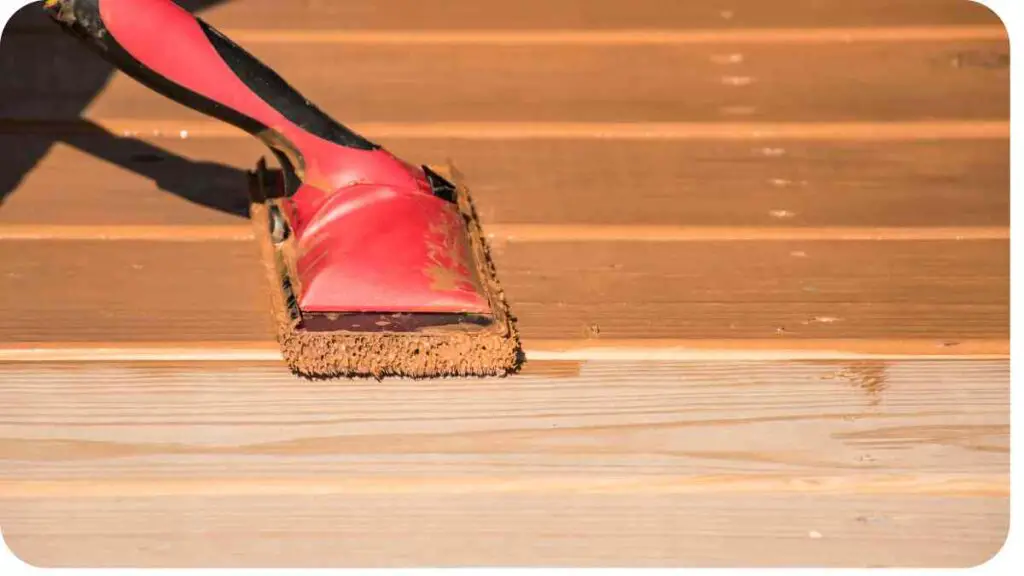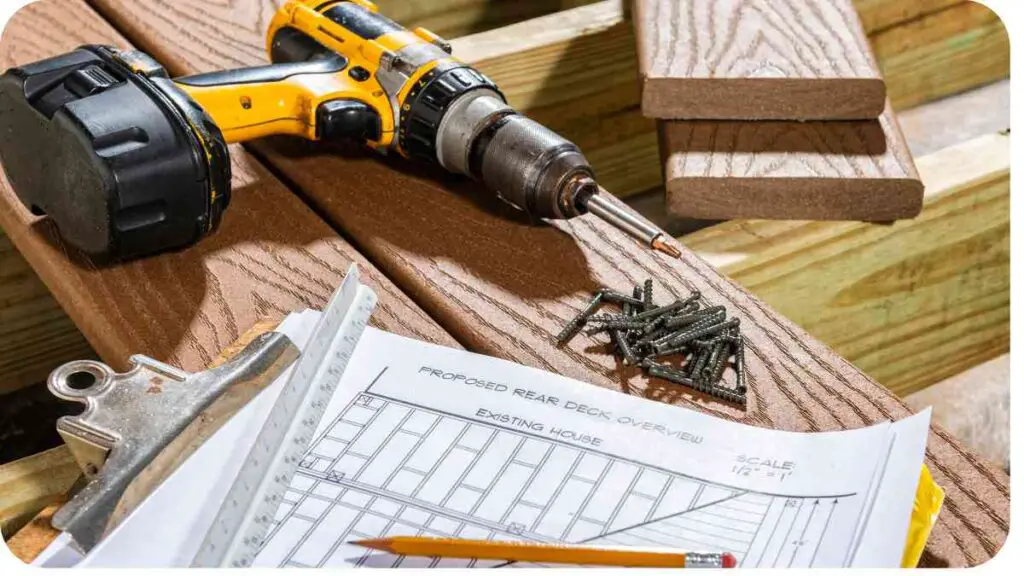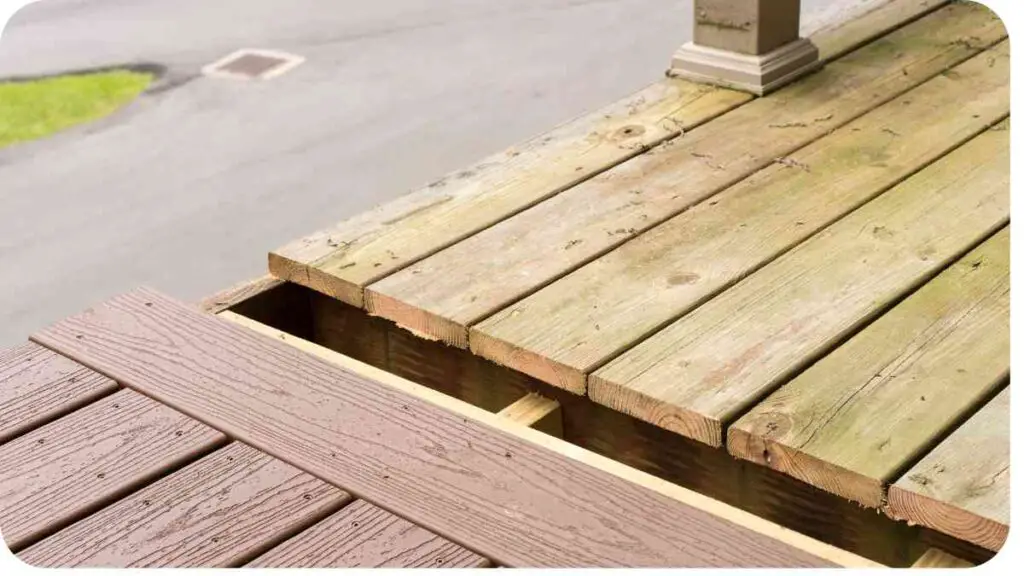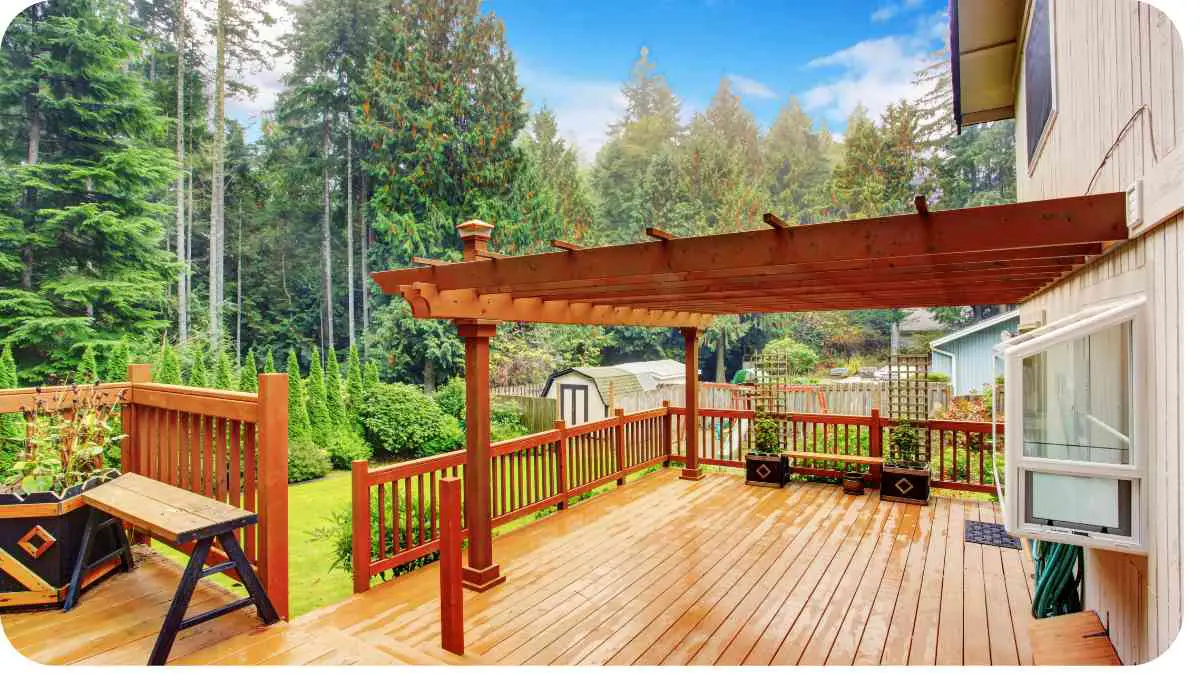So, you’ve decided to build a 10×12 deck – that’s exciting! A deck can significantly enhance your outdoor living space, providing a perfect spot for relaxation, entertaining guests, or enjoying a morning cup of coffee.
However, before you start hammering away, it’s crucial to have a solid plan in place and gather all the necessary materials. In this comprehensive guide, we’ll walk you through everything you need to know to create the perfect 10×12 deck, from planning and material selection to construction and maintenance.
| Takeaways |
|---|
| 1. Proper planning is crucial before starting your deck project. |
| 2. Consider the pros and cons of different deck materials before making a decision. |
| 3. Ensure you have the necessary tools and equipment for the job. |
| 4. Pay attention to deck frame materials for structural integrity. |
| 5. Choose decking surface materials based on durability and maintenance preferences. |
| 6. Select railing materials that enhance safety and complement your deck’s aesthetic. |
| 7. Use high-quality fasteners and hardware for long-lasting construction. |
| 8. Add finishing touches to your deck to enhance its appearance and functionality. |
| 9. Budget carefully for materials, labor, permits, and extras. |
| 10. Prioritize regular maintenance to prolong the lifespan of your deck. |
2. Planning Your 10×12 Deck

Before diving into the material list, take some time to plan your deck carefully. Consider factors such as the deck’s purpose, location, layout, and desired features. Measure the space accurately and determine the best orientation for your deck based on sunlight, views, and existing structures. Additionally, check local building codes and obtain any necessary permits before starting construction.
Enhance your deck with a pergola for added elegance and functionality. Learn how to put a pergola on a deck the right way to create a perfect outdoor retreat.
Table: Deck Planning Checklist
| Considerations | Details |
|---|---|
| Purpose | Relaxation, entertaining, dining, etc. |
| Location | Backyard, side yard, attached to the house, etc. |
| Layout | Single level, multi-level, shape, etc. |
| Orientation | North, south, east, west-facing, etc. |
| Building Codes | Local regulations, permits, setbacks, etc. |
By carefully planning your deck, you’ll ensure that it meets your needs and complies with all necessary regulations.
3. Deck Material Options
The materials you choose for your deck will have a significant impact on its appearance, durability, and maintenance requirements. Here are some popular options to consider:
Wood
Wood is a classic choice for decking due to its natural beauty and affordability. Common wood species used for decks include pressure-treated pine, cedar, and redwood. While wood requires regular maintenance, such as staining or sealing, it can be easily customized to suit your style preferences.
Composite
Composite decking is made from a combination of wood fibers and recycled plastic, offering the look of wood without the maintenance requirements. It’s resistant to rot, decay, and insect damage, making it an excellent choice for low-maintenance decks. Composite decking comes in a variety of colors and textures to mimic the look of real wood.
PVC
PVC (polyvinyl chloride) decking is a synthetic option that is highly durable and resistant to moisture, mold, and mildew. It’s also scratch and stain-resistant, making it ideal for high-traffic areas. PVC decking requires minimal maintenance and is available in a range of colors and styles.
Extend your gardening season by adding heat to your greenhouse efficiently. Discover the easy way to add heat and create optimal growing conditions for your plants, ensuring year-round productivity.
Table: Deck Material Comparison
| Material | Pros | Cons |
|---|---|---|
| Wood | Natural look, affordability | Requires regular maintenance |
| Composite | Low maintenance, durability, variety of colors | Higher initial cost |
| PVC | Highly durable, low maintenance, resistant to moisture | Higher cost, limited color options |
Consider your budget, desired aesthetics, and maintenance preferences when selecting the right material for your 10×12 deck.
4. Tools Needed
Before you start building your deck, make sure you have the necessary tools on hand. Here’s a list of essential tools you’ll need for the job:
- Circular saw
- Power drill
- Level
- Tape measure
- Chalk line
- Framing square
- Hammer
- Safety glasses
- Hearing protection
- Work gloves
Having the right tools will make the construction process smoother and ensure professional-looking results.
Table: Essential Deck Building Tools
| Tool | Purpose |
|---|---|
| Circular saw | Cutting deck boards and framing materials |
| Power drill | Driving screws and drilling holes |
| Level | Ensuring the deck frame is plumb and level |
| Tape measure | Measuring distances and dimensions |
| Chalk line | Marking straight lines on the deck surface |
| Framing square | Checking for square corners |
| Hammer | Driving nails and securing components |
| Safety glasses | Protecting eyes from debris and sawdust |
| Hearing protection | Protecting ears from loud noise |
| Work gloves | Protecting hands from sharp edges |
Gather these tools before you start your deck project to ensure you have everything you need to get the job done safely and efficiently.
5. Deck Frame Materials

The deck frame provides the structural support for your deck, so it’s essential to choose sturdy and rot-resistant materials. Here are the primary materials used for deck framing:
- Pressure-treated lumber: This is the most common and cost-effective option for deck framing. Pressure-treated lumber is treated with preservatives to resist rot, decay, and insect damage, making it durable and long-lasting.
- Cedar: Cedar is naturally resistant to rot and insect infestation, making it an excellent choice for deck framing. It’s lightweight, easy to work with, and adds a touch of natural beauty to your deck.
- Composite: Some homeowners opt for composite materials for deck framing, especially if they’re using composite decking for the surface. Composite framing materials offer the same benefits as composite decking, such as durability and low maintenance.
Ensure stability and safety for your pergola on a deck with proper anchoring techniques. Explore the step-by-step guide on how to anchor pergola to deck to enjoy your outdoor space securely.
Table: Deck Frame Material Comparison
| Material | Pros | Cons |
|---|---|---|
| Pressure-treated lumber | Affordable, readily available | Prone to warping and splitting over time |
| Cedar | Natural beauty, rot-resistant | Higher cost compared to pressure-treated lumber |
| Composite | Low maintenance, durability | Higher initial cost |
Choose the right frame material based on your budget, preferences, and desired level of maintenance.
6. Decking Surface Materials
The decking surface is where you’ll spend most of your time on the deck, so it’s essential to choose a material that’s both durable and aesthetically pleasing. Here are the primary options for decking surface materials:
- Pressure-treated lumber: Pressure-treated lumber is a popular choice for decking surfaces due to its affordability and availability. It’s treated to resist rot, decay, and insect damage, making it a durable option for outdoor use. However, it does require regular maintenance, such as staining or sealing, to prolong its lifespan.
- Composite decking: Composite decking is made from a combination of wood fibers and recycled plastic, offering the look of wood without the maintenance requirements. It’s resistant to rot, decay, and insect damage, making it an excellent choice for low-maintenance decks. Composite decking comes in a variety of colors and textures to suit any style preference.
- PVC decking: PVC decking is a synthetic option that’s highly durable and resistant to moisture, mold, and mildew. It’s also scratch and stain-resistant, making it ideal for high-traffic areas. PVC decking requires minimal maintenance and is available in a range of colors and styles.
Table: Decking Surface Material Comparison
| Material | Pros | Cons |
|---|---|---|
| Pressure-treated lumber | Affordable, readily available | Requires regular maintenance |
| Composite | Low maintenance, durability, variety of colors | Higher initial cost |
| PVC | Highly durable, low maintenance, resistant to moisture | Higher cost, limited color options |
Consider factors such as budget, maintenance requirements, and desired aesthetics when choosing the right decking surface material for your 10×12 deck.
7. Railing Materials
Railing not only adds safety to your deck but also contributes to its overall aesthetic appeal. There are various materials available for deck railing, each with its own unique advantages and considerations:
- Wood: Wooden railing offers a classic and natural look that complements many deck styles. It can be customized with different designs and finishes to match your preferences. However, wood railing requires regular maintenance, such as staining or sealing, to protect it from the elements.
- Composite: Composite railing provides the same benefits as composite decking, including durability and low maintenance. It’s resistant to rot, decay, and insect damage, making it a long-lasting option for your deck. Composite railing comes in a variety of styles and colors to coordinate with your decking material.
- Metal: Metal railing, such as aluminum or steel, offers a sleek and modern aesthetic for your deck. It’s durable, weather-resistant, and requires minimal maintenance. Metal railing is available in various designs and finishes to complement any deck style.
Table: Railing Material Comparison
| Material | Pros | Cons |
|---|---|---|
| Wood | Classic look, customizable designs | Requires regular maintenance |
| Composite | Low maintenance, durability, variety of styles | Higher initial cost |
| Metal | Modern aesthetic, durability | May be more expensive depending on the metal |
Choose the railing material that best suits your budget, style preferences, and maintenance needs to enhance the safety and beauty of your 10×12 deck.
Elevate the style and safety of your outdoor deck with the right railings. Learn about the latest trends and tips for outdoor deck railings that seamlessly blend aesthetics and security for your space.
8. Fasteners and Hardware
Choosing the right fasteners and hardware is crucial for the structural integrity and longevity of your deck. Here are some key components to consider:
- Deck Screws: Use corrosion-resistant deck screws specifically designed for outdoor use. Stainless steel or coated screws are ideal to prevent rust and corrosion.
- Joist Hangers: Joist hangers are metal brackets used to attach the deck frame to the support posts. Choose galvanized steel joist hangers for maximum durability.
- Anchor Bolts: Anchor bolts are used to secure the deck ledger to the house framing. Make sure to use galvanized or stainless steel anchor bolts for rust resistance.
- Post Anchors: Post anchors are used to attach the deck support posts to the concrete footings. Look for heavy-duty post anchors that provide strong support and stability.
- Hidden Fastening Systems: Hidden fastening systems offer a sleek and seamless look for your deck surface by concealing screws and fasteners. They provide a cleaner appearance and reduce the risk of tripping hazards.
Table: Deck Fasteners and Hardware
| Component | Purpose |
|---|---|
| Deck Screws | Securing deck boards and framing components |
| Joist Hangers | Attaching joists to support posts and ledger board |
| Anchor Bolts | Securing the deck ledger to the house framing |
| Post Anchors | Attaching support posts to concrete footings |
| Hidden Fasteners | Concealing screws for a seamless deck surface |
Investing in high-quality fasteners and hardware will ensure the stability and safety of your 10×12 deck for years to come.
9. Finishing Touches
Adding finishing touches to your deck can elevate its appearance and functionality. Here are some final touches to consider:
- Deck Lighting: Illuminate your deck for safety and ambiance with various lighting options, such as post cap lights, stair riser lights, and LED strip lights.
- Deck Skirting: Install deck skirting to conceal the underside of your deck and create a polished look. Skirting can be made from wood, composite, or lattice panels.
- Built-in Seating: Incorporate built-in benches or seating areas into your deck design for added comfort and convenience.
- Planter Boxes: Add planter boxes or railing planters to bring greenery and color to your deck space. Choose weather-resistant materials for long-lasting durability.
- Decorative Railings: Enhance the visual appeal of your deck with decorative railings, such as glass panels, cable railing, or intricate baluster designs.
Make informed decisions about your deck material selection with a comprehensive guide. Explore alternative options and considerations for deck material alternatives to create the perfect outdoor living space tailored to your preferences and needs.
Table: Deck Finishing Touches
| Finishing Touch | Description |
|---|---|
| Deck Lighting | Illuminate the deck for safety and ambiance |
| Deck Skirting | Conceal the underside of the deck for a polished look |
| Built-in Seating | Provide comfortable seating options for relaxation |
| Planter Boxes | Add greenery and color to the deck space |
| Decorative Railings | Enhance the visual appeal of the deck with decorative designs |
By adding these finishing touches, you can create a beautiful and functional outdoor space that you’ll enjoy for years to come.
10. Cost Considerations

Building a deck involves various costs, including materials, labor, and permits. Here’s a breakdown of the expenses you might encounter:
- Materials: The cost of materials will depend on factors such as the size of your deck, the materials chosen, and any additional features or accessories.
- Labor: If you’re hiring a professional contractor to build your deck, labor costs will be a significant portion of your budget. Labor costs can vary depending on the contractor’s rates and the complexity of the project.
- Permits: Many municipalities require permits for deck construction, which come with associated fees. Be sure to factor permit costs into your budget.
- Extras: Don’t forget to budget for extras such as fasteners, hardware, sealants, and any additional finishing touches or accessories.
Table: Deck Cost Breakdown
| Expense | Description |
|---|---|
| Materials | Cost of decking, framing, railing, and other materials |
| Labor | Cost of hiring a professional contractor (if applicable) |
| Permits | Fees for building permits and inspections |
| Extras | Additional costs for fasteners, hardware, and finishing touches |
It’s essential to budget carefully and plan ahead to ensure that you can afford the deck of your dreams without breaking the bank.
11. Maintenance Tips
Proper maintenance is key to preserving the beauty and longevity of your 10×12 deck. Here are some maintenance tips to keep your deck looking its best:
- Regular Cleaning: Sweep your deck regularly to remove debris and dirt buildup. Use a mild detergent and water to clean the surface, and rinse thoroughly with a garden hose.
- Annual Inspection: Inspect your deck annually for signs of wear and damage, such as loose boards, rot, or pest infestations. Make any necessary repairs promptly to prevent further damage.
- Sealing or Staining: Depending on the material of your deck, you may need to seal or stain it every few years to protect it from moisture and UV damage. Follow the manufacturer’s recommendations for maintenance.
- Trim Vegetation: Trim back any vegetation, such as bushes or trees, that may be encroaching on your deck. This will help prevent moisture buildup and reduce the risk of mold or mildew growth.
- Protective Measures: Place mats or rugs under furniture to prevent scratches and wear on the deck surface. Use coasters or saucers under planters to protect the deck from water damage.
Table: Deck Maintenance Checklist
| Maintenance Task | Frequency |
|---|---|
| Regular Cleaning | Weekly or as needed |
| Annual Inspection | Once a year |
| Sealing or Staining | Every 2-3 years (as needed) |
| Vegetation Trimming | As needed |
| Protective Measures | Ongoing |
By following these maintenance tips, you can ensure that your 10×12 deck remains safe, beautiful, and functional for years to come.
12. Building Permits and Codes
Before you embark on your deck-building journey, it’s crucial to familiarize yourself with local building codes and obtain any necessary permits. Here’s what you need to know:
- Building Codes: Building codes regulate the design, construction, and safety standards for decks. These codes may vary depending on your location, so it’s essential to check with your local building department to ensure compliance.
- Permit Requirements: Many municipalities require permits for deck construction, especially for larger or more complex projects. Permit requirements typically include submitting detailed plans, paying fees, and scheduling inspections throughout the construction process.
- Code Compliance: Ensure that your deck design meets all relevant building code requirements, including structural integrity, load-bearing capacity, railing height and spacing, stair dimensions, and foundation specifications.
- Professional Assistance: If you’re unsure about building codes or permit requirements, consider seeking professional assistance from a licensed contractor or building inspector. They can help ensure that your deck project meets all regulatory standards.
Table: Permit and Code Considerations
| Considerations | Details |
|---|---|
| Building Codes | Regulations for deck design, construction, and safety |
| Permit Requirements | Submission of plans, payment of fees, inspections |
| Code Compliance | Structural integrity, railing height, stair dimensions |
| Professional Assistance | Consultation with licensed contractors or inspectors |
By understanding and adhering to building codes and permit requirements, you can ensure a smooth and compliant deck-building process.
13. Safety Precautions
Safety should always be a top priority when building and using a deck. Here are some essential safety precautions to follow:
- Wear Protective Gear: When working on your deck, wear appropriate safety gear, including gloves, safety glasses, and hearing protection. This will help protect you from injuries caused by sharp tools, flying debris, and loud noise.
- Use Proper Techniques: Follow safe construction techniques when building your deck, such as using proper lifting and carrying techniques, securing ladders and scaffolding, and maintaining a clean and organized work area.
- Secure the Site: Make sure your work area is stable and secure before starting construction. Avoid working in inclement weather or on unstable ground, and use temporary bracing or supports as needed to prevent accidents.
- Follow Manufacturer Instructions: When using power tools or equipment, always follow the manufacturer’s instructions and safety guidelines. Use tools properly and maintain them in good working condition to prevent accidents and injuries.
- Childproofing: If you have young children or pets, take steps to childproof your deck by installing safety gates, securing railings, and removing tripping hazards such as loose toys or furniture.
Table: Deck Safety Precautions
| Safety Precaution | Details |
|---|---|
| Wear Protective Gear | Gloves, safety glasses, hearing protection |
| Use Proper Techniques | Proper lifting, securing ladders, clean work area |
| Secure the Site | Stable ground, avoid inclement weather |
| Follow Manufacturer Instructions | Proper use and maintenance of tools |
| Childproofing | Safety gates, secure railings, remove hazards |
By following these safety precautions, you can help prevent accidents and injuries during the construction and use of your deck.
14. Hiring a Professional vs. DIY
Deciding whether to hire a professional contractor or tackle the project yourself is an important consideration when building a deck. Here are some factors to weigh:
- DIY: Building a deck yourself can be a rewarding project that saves money and allows for full customization. However, it requires time, skill, and knowledge of construction techniques. DIYers should be comfortable with power tools and have a basic understanding of building codes and safety precautions.
- Professional Contractor: Hiring a professional contractor can save time and ensure that your deck is built to high standards. Contractors have the expertise and experience to handle all aspects of deck construction, from planning and permitting to building and finishing. They also have access to professional-grade tools and materials.
- Budget: Consider your budget when deciding between DIY and hiring a professional. While DIY may save on labor costs, you’ll need to factor in the cost of materials, tools, and permits. Professional contractors often have established relationships with suppliers and may be able to secure better pricing on materials.
- Time and Availability: Consider your schedule and availability when deciding whether to DIY or hire a professional. DIY projects require a significant time investment, whereas hiring a contractor allows you to focus on other priorities while the work is being done.
Table: DIY vs. Professional Contractor
| Considerations | DIY | Professional Contractor |
|---|---|---|
| Skills and Knowledge | Moderate to advanced construction skills | Expertise and experience in deck construction |
| Budget | Lower labor costs, but higher material costs | Higher labor costs, but potential material savings |
| Time and Availability | Requires significant time investment | Saves time and effort with professional services |
Consider your skills, budget, and availability when deciding whether to tackle your deck project yourself or hire a professional contractor.
15. Conclusion
Building a 10×12 deck can enhance your outdoor living space and provide a beautiful area for relaxation and entertainment. By following the steps outlined in this guide, you’ll be well-equipped to plan, design, and construct the perfect deck for your needs.
From selecting the right materials and tools to understanding building codes and safety precautions, each aspect of deck construction requires careful consideration. Whether you choose to DIY or hire a professional contractor, prioritize safety, quality, and adherence to local regulations throughout the process.
Remember to take your time during the planning and construction phases, and don’t hesitate to seek assistance or guidance from experts if needed. With proper planning, attention to detail, and regular maintenance, your 10×12 deck will provide years of enjoyment for you, your family, and your guests.
If you have any questions or need further assistance, feel free to reach out to us. Happy deck building!
Further Reading
- Menards: 10×12 Attached Single Level Deck Material List: Explore a comprehensive material list for building a 10×12 attached single-level deck from Menards.
- TitanBP: Deck Plan Starter 10×12: Access a deck plan starter kit specifically designed for a 10×12 deck from TitanBP, including layout, materials, and instructions.
- Decks.com: Decking Calculator: Utilize a handy decking calculator from Decks.com to estimate the materials needed for your deck project based on dimensions and material type.
FAQs
What materials are typically needed for a 10×12 deck?
For a 10×12 deck, you’ll typically need materials such as decking boards, framing lumber, railing components, fasteners, and concrete footings.
How much does it cost to build a 10×12 deck?
The cost of building a 10×12 deck can vary depending on factors such as material choices, labor costs, and additional features. On average, you can expect to spend anywhere from a few thousand dollars to upwards of $10,000 or more.
Do I need a permit to build a 10×12 deck?
In many areas, you will need a building permit to construct a deck, especially if it’s attached to your home or exceeds a certain height. Check with your local building department to determine the permit requirements for your project.
What is the average lifespan of a 10×12 deck?
The lifespan of a 10×12 deck depends on factors such as the materials used, maintenance practices, and environmental conditions. With proper care and maintenance, a well-built deck can last anywhere from 10 to 30 years or more.
Can I customize the design of my 10×12 deck?
Yes, you can customize the design of your 10×12 deck to suit your preferences and lifestyle. From the choice of materials to the layout and features, there are endless possibilities for creating a deck that reflects your personal style and meets your needs.

I am Hellen James, a professional handywoman with expertise in improving home and garden spaces by using pergolas, gazebos, and tents.


